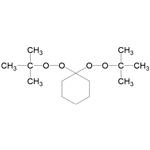Polymerization initiator.
1,1-Di (tert-butylperoxy) cyclohexane (DTBPH) is a commercial liquid organic peroxide that is to be in aliphatic hydrocarbon solvent and transported and stored under limited temperature[1].
The explosive instability of the lower dialkyl peroxides (e.g., dimethyl peroxide) and 1,1-bis-peroxides decreases rapidly with increasing chain length and degree of branching, the di-tert-alkyl derivatives being amongst the most stable class of peroxides. Though many 1,1-bis-peroxides have been reported, few have been purified because of the higher explosion hazards compared with the monofunctional peroxides. 1,1-Di(tert-butylperoxy)cyclohexane is unlikely that this derivative would be particularly unstable compared to other peroxides in it's class, Bretherick 2nd ed., p 44 1979.
Flammability and Explosibility
Not classified
The initial threshold screening level (ITSL) for 1,1-Di-(tert-butylperoxy)cyclohexane is set at trace, 0.1 μg/m3 based on an annual averaging time.
[1] Jo-Ming Tseng . “The thermal hazard evaluation of 1,1-di (tert-butylperoxy) cyclohexane by DSC using non-isothermal and isothermal-kinetic simulations.” Journal of Loss Prevention in The Process Industries 25 4 (2012): Pages 703-708.

